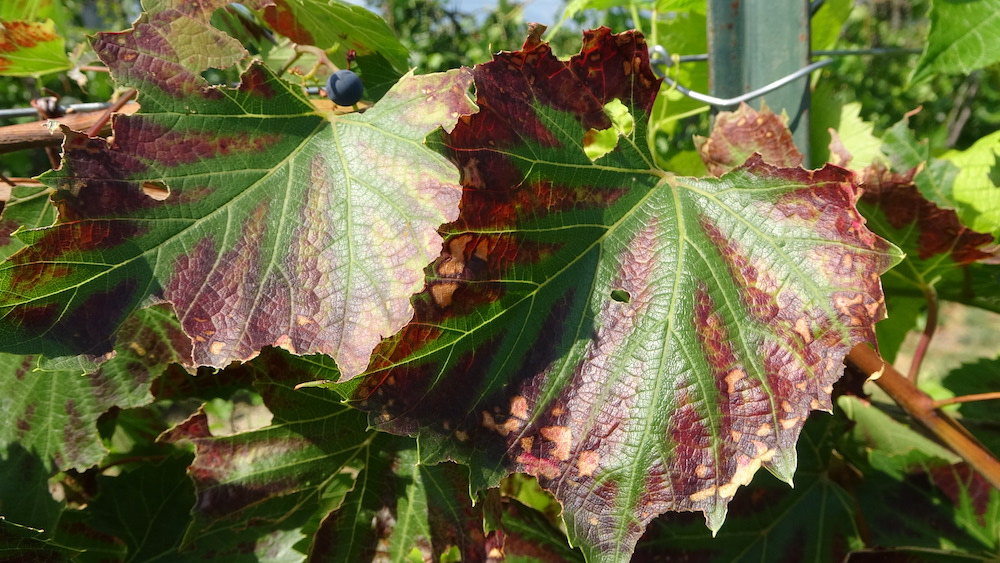Vineyard Fertility
These leaves are showing signs of a Magnesium deficiency in the vine.
The soil in your vineyard plays a crucial role in your vines’ health, affecting everything from vine vigor to pest resistance to cold and drought hardiness. While it is very important to test and amend your soil ahead of planting your vines, it becomes more difficult to make a difference in soil quality once your vines have already been planted. As such, it’s important to incorporate foliar testing and nutrient sprays into your management plan.
Soil and Foliar Testing
Grapes, like all plants, need good nutrition to thrive. Once vines are established, soil nutrient testing cannot give a full picture of the vine nutrition since the roots are much deeper in the soil. That said, soil nutrient testing can provide important information on baseline nutrient levels and pH. Soil pH determines the availability of nutrients in the soil. Grapes prefer slightly acidic soils, typically with a pH between 6.5-7. When the pH of soil is above 8, you will want to consider acidifying the soil. The University of Michigan’s extension program offers a detailed explanation in this resource for how to acidify your soil using Sulfur (PDF). Annual Nitrogen fertilization is recommended in most vineyards since significant amounts are removed each year with harvest and pruning. Rates of application typically range from 10 to 60 pounds of actual Nitrogen per acre, depending on soil type and other management practices. Phosphorous and Potassium are also removed from the soil in high quantities, so it is important to monitor and add these nutrients each season as part of your maintenance program when soil or tissue levels become low.
Foliar — leaf and petiole (leaf stem) — samples can offer a much clearer picture of vine health in your vineyard. Typically, you will not need to utilize foliar sampling until your vines are mature enough to be producing fruit. One exception is if you find visible signs of nutrient deficiency or disease — like chlorotic (yellow) veins and margins, reddened foliage (pictured above), spotting or curling of leaves, etc. — at which point you should submit samples of both healthy and abnormal leaves for analysis, which can then inform your plans for treatment or fertilization.
Once your vines are in production, submitting annual foliar samples for analysis is ideal. While you can submit samples through reputable labs like Agvise or Midwest Labs year-round, it is important to note that certain nutrient concentrations — especially N and K — will change over the growing season. Therefore, the two recommended time frames for foliar sampling are at bloom and between mid-July and mid-August (at latest, as berries are reaching veraison — i.e. turning color and becoming soft).
If you’re submitting samples for a general check-up on your vines’ health, be sure to send a separate sample for each cultivar in your vineyard, as you can find unique issues with nutrient uptake among different varieties. At minimum, you should request results for the following nutrient levels:
- Potassium (K)
- Nitrogen (N)
- Phosphorus (P)
- Magnesium (Mg)
- Zinc (Zn)
- Manganese (Mn)
- Iron (Fe)
- Boron (B)
- Calcium (Ca)
- Sulfur (S)
- Copper (Cu)
The lab will likely present the results within a range of sufficiency for each nutrient, but these can sometimes be misleading for your unique situation. Regardless, if you do find that you need to make amendments via granular fertilizers or foliar sprays, the lab will likely suggest a few options for this, as well.
You can find more detailed descriptions for how to read tissue analysis results during
these two different periods as well as suggestions for managing specific nutrient
deficiencies in the Fertilization and Nutrition section of the University of Minnesota’s Growing Grapes
in Minnesota (PDF) guide.
Applying Foliar Sprays
Micronutrients are most efficiently added as foliar sprays around bloom. The WSU Vineyard Nutrient Management handbook (PDF)provides clear recommendations regarding what, how, and when to apply. Based on a survey of Montana vineyards conducted in 2019, Magnesium, Zinc, and Boron deficiencies were most common, occurring in 32, 39, and 25% of varieties sampled. The nutrient status was based on the results from Carl Rosen (PDF)from University of Minnesota and the Northern Grapes project. Most samples were also low in Copper, but levels of copper deficiency are not certain, so it is not clear that more is needed for vine health. Magnesium can be added to the soil early in the spring or as a foliar spray of Epsom salts (1-2 oz per gallon). Zinc is applied as foliar spray of Zinc Sulfate 2 weeks prior to and 2 weeks after bloom. Boron can be applied either to the soil or as a foliar spray. With any of these applications, be sure to calculate rates carefully, and especially do not over-fertilize with Boron, as too much can be toxic to the vines.


